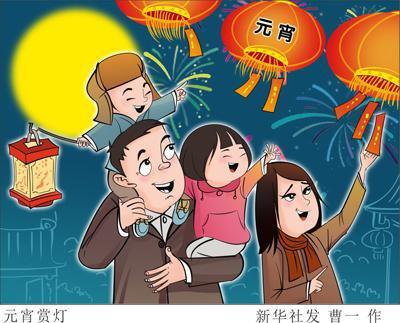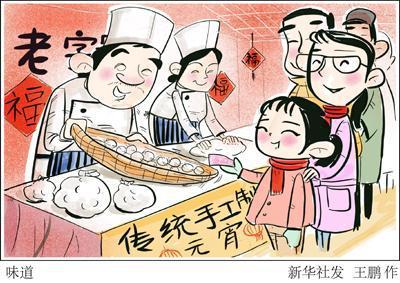Besides eating Lantern Festival lanterns, what other customs are there in all parts of our province? Some things you can’t think of
Today is the fifteenth day of the first month, and the Lantern Festival comes as scheduled. In ancient Chinese, "Yuan" is the beginning, "Xiao" is the night, and "Yuanxiao" is the first full moon night after the beginning of Yuan. Lantern Festival has a long history. As early as the Western Han Dynasty, Lantern Festival has become a major festival.

As a part of the Spring Festival, Lantern Festival is also a chain festival. In terms of length, it was one day in Han Dynasty, three days in Tang Dynasty, and five days in Song Dynasty. In Ming Dynasty, the lights were lit from the eighth day of the eighth month until the night of the seventeenth day of the first month, for ten days. Tang Yin, a poet in the Ming Dynasty, wrote in his poem Yuanxiao: "In spring, people are like jade, and lights burn the moon like silver next month." By the Qing Dynasty, the Lantern Festival in various places had added "hundred plays" such as dragon dancing, lion dancing, roller boating, walking on stilts and yangko dancing, but the festival period was shortened to three to four days, starting from the 14th day of the first month and ending on the 16th.
Two hundred years ago, in Jinan Prefecture, the Lantern Festival was celebrated like this: "Put on lanterns, set off fireworks, and make sugar rounds. Try the lamp (wheat on the 14th, main valley on the 15th, main beans on the 16th), and it will be a good year when the moon is bright and windy. After trying to spread the doors, it is called’ scattered lights’ and floating in the running water, which is called’ river lights’. "

In all parts of Shandong, in addition to the traditional eating dumplings, watching lanterns, watching zaju and setting off river lanterns, "Walking Hundred Diseases" has also been a distinctive folk activity since the Ming and Qing Dynasties. Someone once wrote a poem: "Old and young are happy to call each other, and when they leave, there will be no diseases in the world." This activity is held in some areas on the 15th of the first month, but mostly on the 16th. On this day, women dressed in festive costumes walked out of their homes and crossed the bridge in droves. In some areas, they went to Confucian temples, temples, and some boarded city walls or pavilions until midnight. Little girls play with skipping rope on this day, which is called "jumping a hundred ropes".
In the old days, women in Texas boarded the south gate and walked to the temple pavilion. As the saying goes, "Climbing the city is easy." Longkou women must cross the crescent bridge in Xiguan when they are ill. In Boshan, people who suffer from sores and gangrene will gather Ai Wei on the 16th night of the first month to roast the stone lion in front of the county office, which is called "Treating Diseases". Men, women and children in the rural areas of Juxian county should take a walk in the wild on this day, which is called "walking the old face". It is said that walking once a year can keep the old face.
These three places have the most unique custom of "walking away from all diseases": in Juancheng, people go for a walk outside the village early in the morning, and even ride cows, horses, donkeys and mules to run on the road, which is called "running for a hundred times", and the proverb says: "running once, never seeing old", which is similar to the custom of "walking old" in Juxian. In some places, people climb high and overlook, some go to the tomb of Lin to moxibustion Weng Zhong, and some people moxibustion clothes at home, which is called "moxibustion for all diseases".

In Laowei County (now Weicheng District), "Walking All Diseases" is more distinctive. On the 16th day of the first month, women went to the Zhenwu Temple in the northeast corner of the city to offer incense, and then touched the wooden tiger that Zhenwu Emperor accompanied Zhao Xuantan, commonly known as the "old cat". It is said that touching an old cat will not cause illness for a year. In front of the shrine court, two stone men were moxibustion. It is said that moxibustion on the stone old man and the stone woman did not produce sores for a year, which is collectively called "running old cat". The "Wei County Zhuzhi Ci" included in the "Wei County Records Draft" compiled in 1941 said: "The Xinzheng Festival began after the Lantern Festival, and the old cats ran in the city; In order to be disease-free for a year, Ai Xiang fought to burn the stone man. "
In Gaomi and other places, on the 16th day of the first month, the stalks of trees and grasses are in the shape of a meandering Yellow River, and children are running in a maze-like passage, which is called "running the Yellow River". People in Zoucheng will go to the Kangxi Monument Pavilion in Mengmiao on the 16th day of the first month to touch the tablet. There is a proverb in the local area: "If you touch the head of the tablet, you will never know how to worry;" Touching the donkey will never make you ill. "
In Tengzhou ancient city one hundred years ago, the gates were not closed during the Lantern Festival, and the lights in the city shone as bright as day. Dragon lanterns, lions, clouds, flower boats, bamboo horses, stilts, and the Eight Immortals are all zaju, dancing and singing, boasting and fighting, and fireworks, fireworks, rockets, mud-nest flowers, iron-tube flowers, etc., or flowers or rings, all at once, which are very lively. From 14th to 16th, everyone climbed the city wall, went to the temple to burn incense, and the officials did not forbid it.
Whether eating glutinous rice balls, watching zaju, setting off river lanterns or walking away from all diseases, the Lantern Festival is painted with a thick humanistic background with the help of ceremonies. On the first full moon night in the New Year, facing the moon god who is in charge of drought, flood, wind and hail, it is natural for our ancestors to use various rituals to pray for a bumper harvest and good health in the New Year, and fire has become the best way to communicate with the gods and people. At dusk, they prayed and blessed around the fire, and the clouds soared to communicate with people and gods. Year after year, the years are so long. In these seemingly superstitious and somewhat reasonable ceremonies, the Lantern Festival was born and passed on in the interpretation …
(Reporting by Lu Wei, a client reporter of Volkswagen Daily)
Reporting/feedback